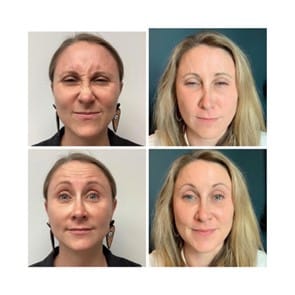“Wrinkles only go where the smiles have been”, or, at least that’s what Jimmy Buffet liked to say. Although we love the perspective that having facial wrinkles means you’ve had lots of happiness in your life, there are many contributing factors, both internal and external, at work to form a wrinkle.
Wrinkles, also known as rhytides in the aesthetic world, are classified into two main types; dynamic and static. Dynamic rhytides are the lines that appear when we make an expression. However, when our face is motionless, the line disappears. Examples of dynamic rhytides include the lines across your forehead that form when you’re surprised or the lines in the middle of your brow that appear when you’re angry. Humans use mimetic muscles, or facial muscles of expression, to communicate nonverbally and display emotion. Our facial muscles allow us to protect vulnerable parts of our bodies like our eyes and mouth, and at the same time allow us to greet each other with a lovely smile or pucker up for a kiss.

These repetitive motions are one of the many contributing factors to the formation of the second type of wrinkle; the static rhytid.
Static rhytides are wrinkles that have become “etched” into the skin. They are present at all times and do not disappear when your face is motionless. Besides not smoking, sun exposure is the most preventable factor involved in the development of static rhytides! Our skin is supported by a substance called collagen, and ultraviolet rays from the sun degrade collagen under the surface of our skin. This degradation of collagen decreases our skin’s elasticity and tightness and contributes to the formation of static lines. Wearing sunscreen (at least SPF 30) not only protects our skin from the formation of skin cancer but gives us the added benefit of protecting us against premature aging!
Other factors that cause wrinkles that are unfortunately not within our control are our genetics, natural aging, and the ever-present effects of gravity. Repeated use of our mimetic muscles, in combination with the effects of collagen loss and the factors above, are the culprits behind this type of wrinkle.

Treatment options vary depending on the type of wrinkle. Dynamic lines are best treated with neurotoxin therapy. With repeated use neurotoxins smooth fine lines and decrease the mimetic muscle’s ability to form a static line. Our top four anti-wrinkle recommendations are:
- Daily use of sunscreen with at least SPF 30
- Medical-grade skincare products that contain ingredients proven to moisturize the skin and protect against free radicals
- Nightly use of retinol to stimulate collagen formation and skin cell rejuvenation
- And our favorite treatment of all (second to microneedling): consistent treatments with neuromodulators like Botox, Dysport, or Jeuveau every three to four months.

If you’ve already developed the etched-in static lines, we have plenty of treatment options! Static lines are best addressed by the implementation of a multi-therapeutic treatment plan. These lines are softened over time with the use of neuromodulators, retinoids, microneedling, and various peels. One of the most efficacious procedures to reduce static lines, increase collagen growth, and improve overall skin texture is a resurfacing treatment with our CO2 laser. Learn more about the CO2 laser and its benefits here.

